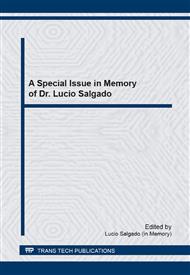p.263
p.272
p.279
p.284
p.291
p.298
p.305
p.311
p.319
Effects of Reduction of Percent of Template (HMI) and Time of Static Synthesis on the Structure of MCM-22 Zeolite
Abstract:
This work aims to study the effects of reducing the level of template HMI (100, 75, 50, 25 and 0% HMI) and time (10, 9 and 8 days) of static synthesis in the structure of MCM-22 zeolite. The synthesis of the MCM-22 (P) precursors was carried out by using hexamethyleneimine (HMI) as organic template under static conditions. The MCM-22 zeolites (100, 75 e 50% HMI) was obtained by the calcination of precursors MCM-22 (P) in a muffle to remove the occluded organic of precursors. These materials were characterized by X-ray diffraction (XRD), spectroscopy of X-ray for energy dispersive (EDX), adsorption isotherms of N2 (BET method), Fourier transform infrared spectroscopy (FT-IR) and scanning electron microscopy (SEM). The XRD's and EDX's of all samples have confirmed the static synthesis of MCM-22, whose precursor and zeolite materials showed all the characteristic peaks of the topology MWW. The Adsorption isotherms of N2 are of type I, represented by microporous materials, whose hysteresis (type H3) are representative of solids with pores of different geometries. The FTIR's shown that the precursors showed the characteristic bands of a laminated material. From the SEM's, it was found the samples calcined MCM-22 are constituted by strip-shaped crystals agglomerated with a depression in the central region. In the sample MCM-22 (P) 75% HMI (8 days), showed no crystals uniform due to the presence of unreacted material in relation to crystalline phases.
Info:
Periodical:
Pages:
291-297
Citation:
Online since:
September 2014
Price:
Сopyright:
© 2015 Trans Tech Publications Ltd. All Rights Reserved
Share:
Citation:


